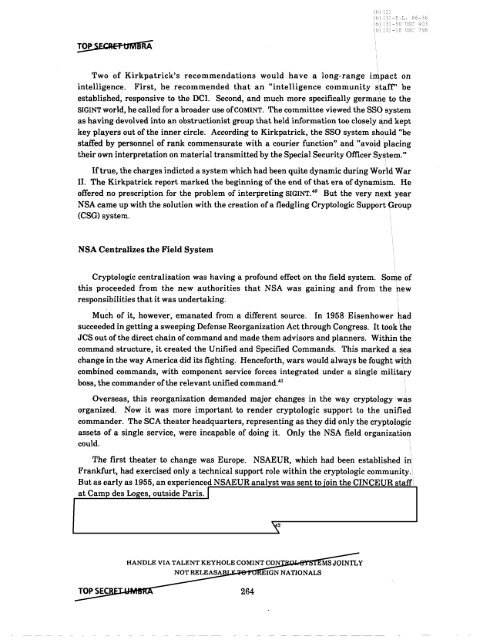American Cryptology during the Cold War - The Black Vault
American Cryptology during the Cold War - The Black Vault
American Cryptology during the Cold War - The Black Vault
You also want an ePaper? Increase the reach of your titles
YUMPU automatically turns print PDFs into web optimized ePapers that Google loves.
-TOP SECRET bMBRA<br />
Ib) (1)<br />
Ib) (3) -P.L. 86-36<br />
Ib) (3) -50 USC 403<br />
Ib) (3) -18 USC 798<br />
Two of Kirkpatrick's recommendations would have a long-range impact on<br />
intelligence. First, he recommended that an "intelligence community stafr' be<br />
established, responsive to <strong>the</strong> DCI. Second, and much more specifically germane to <strong>the</strong><br />
SIGINT world, he called for a broader use ofCOMINT. <strong>The</strong> committee viewed <strong>the</strong> SSO system<br />
as having devolved into an obstructionist group that held information too closely and kept<br />
key players out of<strong>the</strong> inner circle. According to Kirkpatrick, <strong>the</strong> SSO system should "be<br />
staffed by personnel of rank commensurate with a courier function" and "avoid placing<br />
<strong>the</strong>ir own interpretation on material transmitted by <strong>the</strong> Special Security Officer System."<br />
Iftrue, <strong>the</strong> charges indicted a system which had been quite dynamic <strong>during</strong> Wodd <strong>War</strong><br />
II. <strong>The</strong> Kirkpatrick report marked <strong>the</strong> beginning of <strong>the</strong> end of that era of dynamism. He<br />
offered no prescription for <strong>the</strong> problem of interpreting SIGINT. 4o But <strong>the</strong> very next year<br />
NSA came up with <strong>the</strong> solution with <strong>the</strong> creation ofa fledgling Cryptologic Support Group<br />
(CSG) system.<br />
NSA Centralizes <strong>the</strong> Field System<br />
Cryptologic centralization was having a profound effect on <strong>the</strong> field system. Some of<br />
this proceeded from <strong>the</strong> new authorities that NSA was gaining and from <strong>the</strong> new<br />
responsibilities that it was undertaking.<br />
Much of it, however, emanated from a different source. In 1958 Eisenhower had<br />
succeeded in getting a sweeping Defense Reorganization Act through Congress. It took <strong>the</strong><br />
JCS out of<strong>the</strong> direct chain ofcommand and made <strong>the</strong>m advisors and planners. Within <strong>the</strong><br />
command structure, it created <strong>the</strong> Unified and Specified Commands. This marked a sea<br />
change in <strong>the</strong> way America did its fighting. Henceforth, wars would always be fought with<br />
combined commands, with component service forces integrated under a single military<br />
boss, <strong>the</strong> commander of<strong>the</strong> relevant unified command. 41<br />
Overseas, this reorganization demanded major changes in <strong>the</strong> way cryptology was<br />
organized. Now it was more important to render cryptologic support to <strong>the</strong> unified<br />
commander. <strong>The</strong> SCA <strong>the</strong>ater headquarters, representing as <strong>the</strong>y did only <strong>the</strong> cryptologic<br />
assets of a single service, were incapable of doing it. Only <strong>the</strong> NSA field organization<br />
could.<br />
<strong>The</strong> first <strong>the</strong>ater to change was Europe. NSAEUR, which had been established in<br />
Frankfurt, had exercised only a technical support role within <strong>the</strong> cryptologic community.<br />
But as early as 1955, an experienced NSAEUR analyst was sent to ioin <strong>the</strong> CINCEUR staff<br />
at Camp des Loges, outside Paris. I<br />
HANDLE VIA TALENT KEYHOLE COMINT CON<br />
MSJOINTLY<br />
;LE..::pe'1"r:l:tU:IGN NATIONALS<br />
264
















